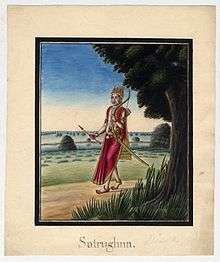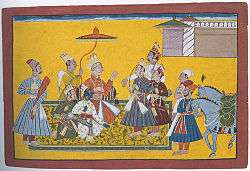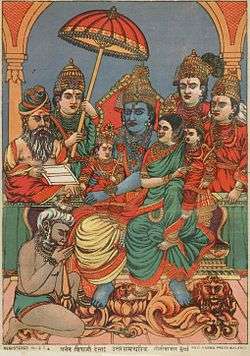Shatrughna
| Shatrughna | |
|---|---|
 Shatrughna, the youngest brother of Rama | |
| Information | |
| Spouse(s) | Shrutakirti |
| Children |
Shatrughati Subahu |
Shatrughna was the youngest brother of Lord Rama in the Hindu epic Ramayana. He is twin brother of Lakshmana. According to Valmiki Ramayana, Shatrughna is one half component of manifest Vishnu (Rama).
Etymology
In Sanskrit, the word Shatrughna means killer of enemies. Shatrughna appears as 412th name of Vishnu in Vishnu sahasranama of Mahabharata.
Birth & Family

Shatrughna was born to the virtuous king of Ayodhya, Dasharatha and his third wife, Queen Sumitra, princess of Kashi. Dasharatha's other two wives, Kaushalya and Kaikeyi, had sons as well. Kaushalya had Rama and Kaikeyi had Bharata who were Shatrughna's half-brothers. Shatrughna's twin brother was Lakshmana. Shatrughna's name means destroyer of enemies. Shatrughna was married to Shrutakirti, daughter of Kushadhwaja, Janaka's younger brother. Thus, Shrutakirti was Sita's cousin. He is supposed to be the reincarnation of Vishnu's sacred chakra and Shrutakirti is supposed to be reincarnation of Lakshmi's sacred chakra. They had two sons - Shatrughati and Subahu.
Rama's Exile

When Rama is exiled, Shatrughna drags Kaikeyi's old nurse Manthara(who was responsible for poisoning the queen's mind against Rama) and makes an attack to kill her, but he is restrained by Bharata who feels that Rama would not approve.
Bharata goes to Rama and asks him to come back to Ayodhya but Rama refuses. Bharata rules Ayodhya from Nandigramam and is an excellent leader, often referred to as the avatar of dharma. Though Bharata was the king designate of Ayodhya during Rama's exile, it was Shatrughna who took care of the administration of the whole kingdom, during Rama's absence. Shatrughna also was the only solace for the three Queen mothers during the absence of Rama, Lakshman and Bharata from Ayodhya.
Rebuked Manthara
Manthara appears only once in Ramayan after Rama's banishment. Having been rewarded by Kaikeyi with costly clothing and jewels, she is walking in the palace gardens when Bharata and his half-brother Shatrughna come upon her. Seeing her, Shatrughna flies into a violent rage over Rama's banishment and assaults her murderously. Kaikeyi begs Bharata to save her, which he does, telling Shatrughna that it is a sin to kill a woman and that Rama would be furious with them both if he does such a thing. He relents and the brothers leave, while Kaikeyi attempts to comfort Manthara.
The Slaying Of Lavanasura

Although he plays a relatively minor role in the Ramayana, Shatrughna is important to the main story and goal of the epic. His chief exploit is the killing of Lavanasura the demon King of Mathura, who was a nephew of Ravana, the King of Lanka, slain by Rama.
Lavanasura was the son of Madhu, the pious demon-king after whom the city of Mathura was named. Madhu's wife and Lavanusara's mother Kumbhini was sister of Ravana. Lavanasura was holder of the divine Trishula(Trident) of Lord Shiva and nobody was able to kill him or prevent him from committing sinful activities.
Shatrughna begged Rama and his elder brothers to allow him the opportunity to serve them by killing Lavanasura. Shatrughna killed the great demon with an arrow imbibed with the power of Vishnu. After Lavanasura's death, Rana coronated him as the king of Mathura.
Retirement
After Rama, the seventh Avatar of Vishnu completes 10, 000 years of perfectly pious rule upon earth, he walks into the river Sarayu to return to his true and eternal Mahavishnu form. Bharata and Shatrughna follow him into the river and merge into Mahavishnu.
Temples
- Shatrughna Temple at Payammal in Thrissur District of Kerala
- Shatrughna Temple at Muni Ki Reti, Rishikesh
- Shatrughna Temple near Kans-tila, Mathura, UP

.jpg)
